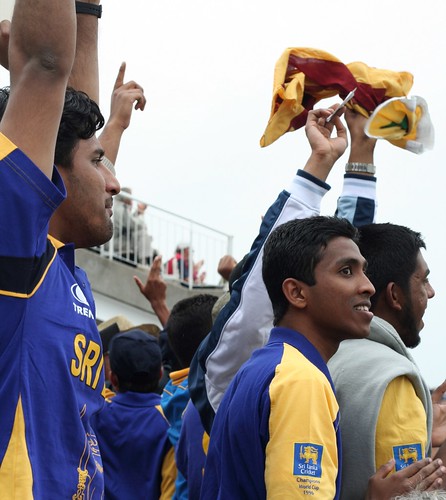
I’ve been back for more than a month, but had this half-done blog post lying around, so I thought I’ll just blog it anyway, I’ve let these little things go without really penning keying my thoughts on them, it’s a worthwhile exercise to do, for my own recollection more than anything else.
If I find time, I might dwell on some of those past experiences, but that’s just a big ‘if’, ‘cos despite having this blog for about a year now, I’ve never really got in the habit of blogging. Which might actually be a good thing, but I’ve always had plenty of things to say, and not nearly as many people to listen to. So perhaps I would blog more.
Anyway..
The reason for the visit was a
Beyond Borders Camp, perhaps the last major gathering of BB members before we wind up next year.
Delhi The
UL flight we were supposed to be on, was Usually Late taking off from Katunayake and as such, our arrival in New Delhi was somewhat delayed. The Delhi Airport was all right, without being really great; you could probably rate it alongside the
BIA.
Once the annoying paperwork was done, (btw, Airport procedures, worldwide - are crap. I just can’t understand why I have to fill in the same info a million times, within the same trip– it’s the 21st century for haven’s sake) we were greeted first by our chauffeurs then by a bald headed man, in a Ghandi-like suit carrying a fair sized rock who in no kind words asked us to bugger off to where ever we came from. Apparently there are some, ahem.. ‘Nationalist elements’ roaming about the airport. I found the whole thing funny, but a few of my female companions were a bit shaken. Obviously this man was a bit mentally handicapped (perhaps like most nationalists).
Our destination was about a forty minute drive from the airport. Delhi certainly has its own flavor, but bits of it reminded me back home, most of it is a mix between pettah and Flower road. Sometimes you’d see boutiques, sometimes gardens. The cars on the road were mostly Indian, Tuk-tuks are painted green and yellow, you could hardly see a Mercedes or a BMW, but they tell me it’s more common than it used to be. Cable TV means most of the Indian brands and even products, are familiar. I could even hum the
Airtel tune if I wanted to. The roads though, are invariably better than back home.

The Sanskiriti Kendra, the location of our residential camp was situated at the very outskirts of Delhi, the Kendra a very calm sort of place, a sanctuary for artists and the likes, wonderfully landscaped with cottages, trees and ponds. The place serves 100% vegetarian food, now this was an experience I’m going to remember. Thankfully though the food was good, and I liked the change.
Food-aside, I was looking forward to meeting the BBites. Some of whom I’ve met before. Beyond Borders worldwide is a one big family of sorts, I’ve never met a bunch of people who are as vibrant and accepting as these ones. Sadly, BB Bangladesh, and Pakistan were not in attendance for the camp. This was pretty much a
Delhi-Mumbai-Colombo affair.
The SessionsBeyond Borders, as a project under the British council was initiated under the themes of Identity, Diversity and Active Global Citizenship. Abstract nature of these themes, means there’s room for much exploration within these concepts, and the sessions at the camp dealt with these concepts, some times in an abstract sense and mostly in their practical manifestations. Some of the sessions were on topics such as secularism, social entrepreneurship, public policy, gender stereotypes, media for social change, faith, and many more. A thorough treatment of all these would mean a kind of a report on this blog, something I’m not prepared to do. Therefore I would touch on a few sessions I really liked, and perhaps blog about the rest in more detail later.
I most enjoyed the session titled Public Policy, conducted by
Dr. Parth J Shah from the
Centre for Civil Society, a leading think tank and an advocacy group based in Delhi. Part of the workshop involved coming up with policy solutions to common problems. Our subgroup focused on the problems of the Indian three wheeler (or auto-rickshaws as they call it) industry, I was ecstatic since I was finally given a chance to put my tuk-tuk observations to the test. Sri Lankan three-wheeler industry is a shining example of the how industries without regulation can prosper, compared to the Indian scenario, where the industry faces heavy regulation, which serves neither the drivers nor the consumers.
Dr. Shah has is the founder and president of CCS is an organization which promotes freedom, both in people and in markets. I was truly inspired by the work of CCS and Dr. Shah, and the amount of minds their advocacy can change. It made a believer out of me, change truly is possible. I only wish they could do some of their seminars in Colombo.
Another wonderful person I met is
Mukul Kesavan, a professor of history from the
Jamia Millia Islamia (National Islamic University), in New Delhi who led a session on ‘Secularism, Religion and Conflict’. This was one of the most thought provoking discussions I’ve had for along time, as well as being a more than a relevant topic to the times we live in.
The discussion touched on conflicts around the world from religious to ethnic, we discussed at length about religious secularism around the world, from the form of secularism practiced in India, to the separation of church and the state in the US to the French model of secularism, to various comments made by Inzamam, Dean Jones,
Jack Straw and of course the
Pope. The discussion also focused on the types of nationalisms, based on linguistic, ethnic and religious identities and the formation of nation states purely on the said identities, he discussed at length about the Indian partition and the creation of Pakistan, to a fruitful discussion on the Jewish state of Israel, as well as the conflict in the Middle East. In particular he kept referencing with ease and at length to the Sri Lankan conflict, and the Tamil demand for self-determination.
This was refreshing as I’ve never met a foreigner having such deep understanding about the Sri Lankan conflict. Later over lunch in a conversation which touched on Kumar Sangakara as well as Mangustine, Mukul explained that ‘Sri Lanka’ is in fact, a quite a frequent topic in Indian academic circles.
There were few more interesting people and sessions worth extending this already extended post. One was a bloke called Arijit Roy of Jagran who led the session on Media for Social Change, blogging was mentioned in passing, but it would be stretching the imagination a little to suggest that blogs can be considered a serious tool for social change. Surely it would come along, but certainly its not there yet, not in the developing world at least.
Arijit’s choice of media was the mime theatre, where Arijit’s organization, - Jagran - uses it to explore difficult issues such as rape, sexual health and HIV. It was encouraging to note that Jagaran work with the Delhi police, who have taken a keen interest in the theatre as a medium to communicate with the general public, especially in cases of rape (sometimes by family, and extended family) which rarely gets reported.
We ended the sessions with a wonderfully colorful BB alumni night, where all of the BBites from past to the present was invited BB, I even had to dress up in the Mahinda Chintana outfit…ahh.. the things I do for my country..
Delhi ShoppingAfter winding up in Sanskirti Kendra we returned back to central Delhi, where we had a day and a little more for whatever we want to do. We haven’t done a whole lot of sight seeing except, a evening visitto the India gate. But my companions wanted to just shop.

Shopping in Delhi (like most places in the world) is more of a ‘woman-thing’, there’s the posh kind of malls you’d expect from a city and then there are like literally hundreds of boutique kind of shops which sells anything from pajamas to perfume and everything in between. In addition there are dozens of street-hawkers trying to sell stuff like socks, handkerchiefs and even books. Most buggers were annoying, they just don’t go away, so much so, that I felt like buying some of the stuff just to send them away. Stuff they have, of course are dirt cheap, but obviously inferior in quality. There are some useful ‘hawkers’ though, I managed to find a cheap copy of seven habits by Covey. Something I always wanted to pick up. All in all, Delhi’s probably not exactly my kinda place for shopping, there’s not a lot of electronic stuff, and the malls are kind of spread out. But it’s all right, especially if your after sarees, jewellery, cotton and traditional sort of stuff; I was obviously not, so while all the women were having a field day at these boutiques, and Saree shops I headed off to Ansal Plaza, the only sort of proper mall I had time to drop into, the mall is home to most international brands, like Lacoste and Marks & Spencer. There are also some music stores and watches and whatnots you’d also get the food outlets, with all the usual suspects and stuff like Subway, which you don’t get here.
All good things, as they say, have to come to an end. When all the good byes, and the hugs were done we had to fly back home. It was a wonderful experience; I’d never thought I’d actually miss India. Most of all I miss the Indians, and the sort of kick you’d get from being with like-spirited people. One moment you’re just singing some Hindi song, and the next you could be having a passionate debate on religion or language homogeneity. Good times.
Deane.


















